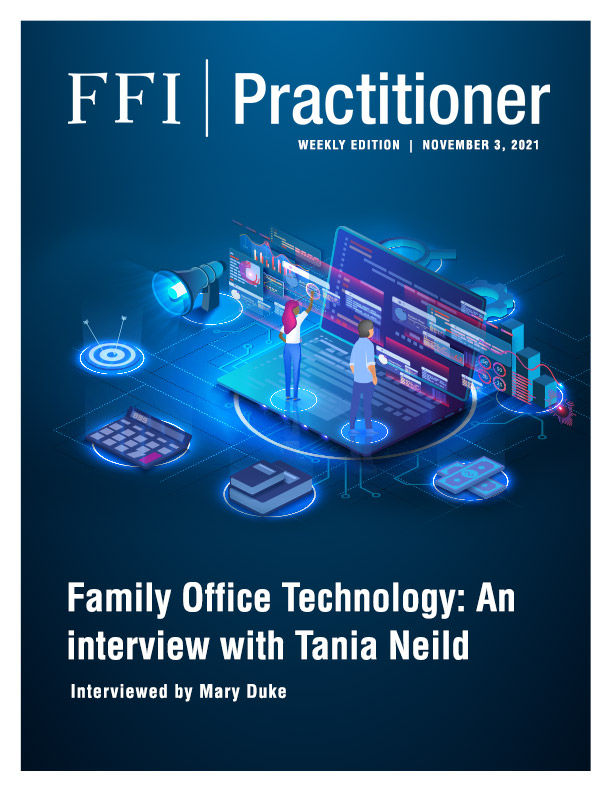
Mary Duke (MD): At the core of every family office’s technology stack is the accounting system. Historically, we’ve watched, waited, and even trialed new applications that promise to “do it all.” Are we any closer to a solution?
Tania Neild (TN): Colloquially, we’ve referred to this dreamy, near-mythological program in the industry as the “killer app”—the one program that could address the six primary types of family office accounting needs, namely trust, general ledger, fund, partnership, portfolio management, and tax. To date, a handful of available systems can do several of these accounting types well, but no platform has been able to reliably integrate all six types. What this means it that a primary focus of my work is on building integrations of systems, of accounting types, and of workflows.
MD: So, the killer app remains elusive! Are there any areas where you are seeing positive change?
TN: What I am seeing is an interesting evolution in an adjacent, but no less critical, technology need in family offices: systems that manage non-accounting data.
Non-accounting data is autological: it simply describes all information living in the family office that is separate from accounting data. While accounting is obviously a critical piece in the overall functioning of a family office, non-accounting data is also of pivotal importance and should be managed accordingly.
Examples of non-accounting data include tax documents, contacts, key dates, tasks, schedules, partner roles/relationships, key clauses, and information on a family’s vendors, real estate, loans, trusts, and even the family’s art. Historically, family offices had to handle this data manually, using email folders and Excel spreadsheets.
MD: We have all encountered the tools that have been adopted in this space, like data vaults and cloud solutions. Is there more to it?
TN: Today, there are some remarkable advances in supporting tools and technology to process all of this discrete yet loosely related non-accounting data. The two tools with the most significant impact are Artificial Intelligence (AI) Document Reading and Cash Flow Forecasting.
The volume of documents a family office processes is staggering: position statements, tax and trade reporting, invoices, accounts payable, statements of private equity, et al. Historically, family office employees processed all paperwork and organized pertinent data manually. More recently, offerings to scan and isolate key information have been available but limited in functionality, primarily through a technology called OCR (Optical Character Recognition). OCR works off templates. This technology works well when processing consistent vendor documents, but any change to a vendor’s document layout (on an invoice, for example) breaks the OCR system’s ability to extract data. Similarly, a family office is likely to work with a significant number of vendors, each of whom send invoices in different layouts. Programming an OCR system to read each layout type from a class of vendors is almost as time consuming as processing all the data manually!
Today, family office technology providers are rapidly developing AI Document Reading tools that address the common pitfalls of OCR. AI systems are much more resilient: with every document the system processes, it “learns” more about key differences between document types and even vendor brand layouts. We’re even seeing providers that specialize in data type, such as alternative statement reading, tax document reading, and receipts (such as invoices and accounts payable).
While AI Document Reading has been on the market for a few years now, affordability used to be a major roadblock for family offices; AI providers would generally only offer enterprise-level software built for global conglomerates such as JP Morgan—and with a price tag to match! However, these software providers have recently introduced plans for smaller businesses, including single and multi-family offices. Now more than ever, is it advisable for family offices to implement an AI Document Reading system.
MD: So you are saying that with AI Document Reading, family offices now have a technology that can virtually replace a human data processer with little intervention required!
In addition to this, how has technology evolved to support cash flow forecasting—a true art form in the family office?
TN: A typical family office must integrate cash sources and use from a vast number of entities, ranging from traditional investments to real estate projects to intra-family and intra-entity loans. Historically, cash flow forecasting systems neglected to acknowledge the variety and nuance found in the tapestry of a family’s entity collection: commitments of gifts/charities, trust pay outs, partnership clauses, taxes, real estate developments, insurance, alimony, and expenses such as art, islands, and jets.
Sidebar
To explore these previous editions, click on the link below.
MD: Focusing on investments and asset allocation alone has never been enough. The challenge has been to track and project cash movement across these complex ownership structures. How is this happening?
TN: Absolutely! Family offices require software that can not only pull balances for accounts and investments but can also compare schedules that they can use to forecast cash needs in various entities.
Let’s take the example of a family who has a significant tax bill coming up. That family needs to identify the source of the cash to pay the bill; they must ensure the cash comes from the correct entity. Furthermore, the family needs a way to forecast that cash flow. Perhaps they’d like to simulate a few different scenarios and weigh the costs/benefits of each.
Historically, the way a family office would conduct an analysis for the above example involved a great deal of manual work. A family office would have one Excel spreadsheet for all of a family’s trusts, another for gifts, another for insurance, and so on. Other family offices would organize on a per-entity basis in other ways. The amount of hours required to forecast cash flow for a single scenario was astronomical.
Today, there are offerings on the market that can integrate cash flow-related data, allowing a family office to examine data across type and entity and to drill into those details to obtain a full picture of a family’s cash needs. This is an important development in the family office space, but it is often overshadowed by other technology topics, such as accounting platform solutions.
In short, AI Document Reading and Cash Flow Forecasting are the two latest and greatest developments in family office technology outside of accounting. Accounting is still the bread and butter of a family office, but AI and Cash Flow Forecast systems are unique and forthcoming and add value by cutting down manual work and by providing a greater amount of accuracy in non-accounting data management.
MD: I am intrigued by your past work with the NSA. You seem uniquely equipped to help families in a world where data and system security seem increasingly threatened. Do you have any advice for family offices from a security perspective?
TN: While we love to tackle the complex needs of family offices, we never neglect the obvious: security. While I can write an entire article (or series of articles, for that matter) on the topic of family office security, I’ll leave the readers with one pivotal piece of advice: everyone in the office, family members and employees alike, should enable two factor authentication (2FA) wherever possible for online accounts. Most financial institutions and social networks provide this option. As the name suggests, two-factor authentication requires two steps to gain access to an account: entering a password and entering a unique temporary code sent directly to the user at the time of login.
Two-factor identification is low hanging fruit; users can turn it on by simply checking a box or two in an app’s settings, and it is an easy way to add another layer of security to login portals. It’s an excellent start to keeping a family’s data, both accounting and non-accounting, safe and secure.
MD: Tania, thank you for sharing your thoughts with the FFI Practitioner audience about these important topics relating to technology for family offices to consider.


Up Next Week

“The Family-Focused Office”

